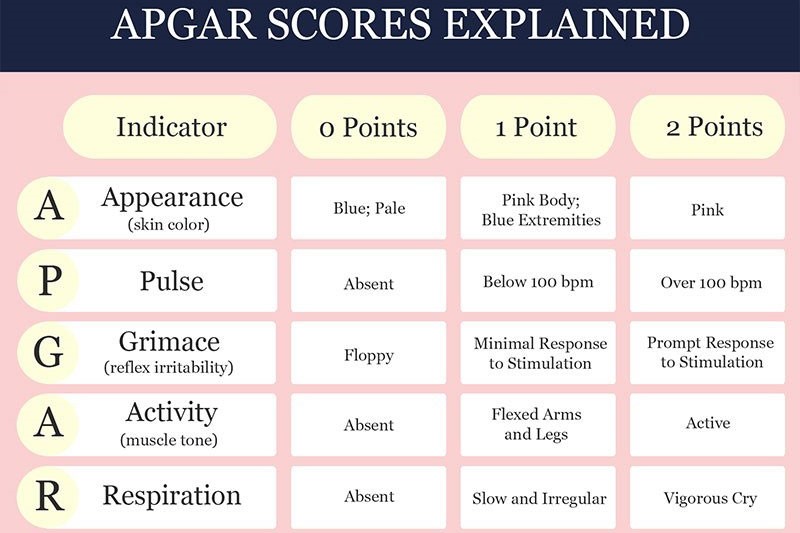
APGAR test and score: assessing the health status of an newborn
The APGAR test is used for assessing newborns: you should assess a newborn at 1 minute and 5 minutes after delivery
It was named after Virginia Apgar, a US paediatrician who created this rating scale.
Judge each of the following categories on a scale of 0-2. If your total is above 7, it’s considered normal; below 3 is critically low.
APGAR stands for:
- Appearance (skin color)
- Pulse (heart rate)
- Grimace (irritability)
- Activity (muscle tone)
- Respiration (work of breathing)
APGAR, The Scoring System!
Assign the following points based on your finding:
Appearance (skin color)
2 – Pink
1 – Chest and abdomen pink, extremities blue
0 – Blue all over
Pulse (heart rate)
2 – HR greater than 100
1 – HR between 60 and 100
0 – HR less than 60
Grimace (irritability)
2 – Coughs, cries and jerks away when stimulated
1 – Weak cries, irritated face, not very angry when poked
0 – No response to stimulation
Activity (muscle tone)
2 – Lots of active movement
1 – Some flexion of the extremities
0 – No movement
Respiration (breathing)
2 – Strong and regular respiration (strong cry is a good indicator of strong respiration.)
1 – Weak or irregular respiration
0 – Not breathing
So, you just assisted in a home delivery.
You are doing your 1 minute APGAR assessment.
The baby is pink all over, HR 95, is highly irritated when you mess with him, moved around actively with good muscle tone, and is crying his heart out and breathing well.
What do you document your APGAR score to be here?
Lets break it down by section:
Appearance – 2 ( pink color)
Pulse – 1 (HR is between 60 and 100)
Grimace- 2 (very irritated)
Activity -2 (good tone)
Respiration -2 (strong cry)
The total APGAR score for this newborn would probably be 9!
The APGAR score doesn’t hold a lot of correlation for the long term health of the child, but its a decent tool for measuring the degree of success of your resuscitation efforts.
If my 1 minute APGAR was 3, and I started an adjunct airway, performed positive pressure ventilation with oxygen… my 5 minute APGAR could be really useful in letting me know how my resuscitation efforts are doing.
Remember that you’re going to be wound up when assisting in the delivery of a newborn.
Just remember to suction, dry, stimulate and assess.
That’s mostly it for a normal pregnancy.
Always document your 1 and 5 minute APGAR scoring in your patient reports
Read Also:
Emergency Live Even More…Live: Download The New Free App Of Your Newspaper For IOS And Android
Seizures In The Neonate: An Emergency That Needs To Be Addressed
Emergency-Urgency Interventions: Management Of Labor Complications
What Is Transient Tachypnoea Of The Newborn, Or Neonatal Wet Lung Syndrome?
Tachypnoea: Meaning And Pathologies Associated With Increased Frequency Of Respiratory Acts
Postpartum Depression: How To Recognise The First Symptoms And Overcome It
Postpartum Psychosis: Knowing It To Know How To Deal With It
Childbirth And Emergency: Postpartum Complications
European Resuscitation Council (ERC), The 2021 Guidelines: BLS – Basic Life Support
Pre-Hospital Seizure Management In Paediatric Patients: Guidelines Using GRADE Methodology / PDF
New Epilepsy Warning Device Could Save Thousands Of Lives
Understanding Seizures And Epilepsy
First Aid And Epilepsy: How To Recognise A Seizure And Help A Patient
Childhood Epilepsy: How To Deal With Your Child?
Epileptic Seizures: How To Recognise Them And What To Do



